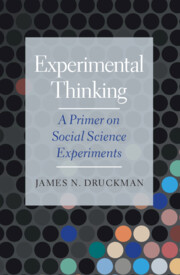Refine search
Actions for selected content:
2 results

Experimental Thinking
- A Primer on Social Science Experiments
-
- Published online:
- 12 May 2022
- Print publication:
- 12 May 2022
2 - Conjoint Survey Experiments
- from Part I - Experimental Designs
-
-
- Book:
- Advances in Experimental Political Science
- Published online:
- 08 March 2021
- Print publication:
- 01 April 2021, pp 19-41
-
- Chapter
- Export citation
